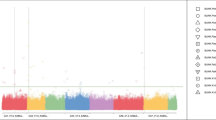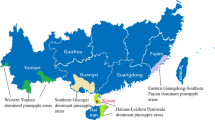Abstract
Of the four high-protein genotypes isolated after induced mutations and breeding, two exhibited height and yield nearly equal to the Bonneville pea variety, but matured later. Their stability for protein yield over generations and locations, aminogram pattern and nutritional value remains to be determined. Path analysis and correlations indicate that developing a short-statured pea with higher yield and increased protein content may not be possible with the available breeding methods and germ plasm.
Similar content being viewed by others
References
Adams G (1975) Mutations affecting protein characters in wheat. In: Proc symp seed protein improvement using nuclear techniques. Vienna: IAEA, pp 35–37
Benken II (1966) A biochemical study of agro-ecological groups of peas. Field Crop Abstr 20:340
Blixt S (1979) Natural and induced variability for seed protein in temperate legumes. In: Proc symp seed protein improvement in cereals and grain legumes, vol 2. Vienna: IAEA, pp 3–21
Breese EL (1969) The measurement and significance of genotype-environment interaction in grasses. Heredity 24:27–44
Bressani R, Elias LG (1979) The world protein and nutritional situation. In: Proc symp seed protein improvement in cereals and grain legumes, vol 1. Vienna: IAEA, pp 3–23
Burton GW (1952) Quantitative inheritance in grasses. Proc 6th Int Grassland Congr 1:119–134
Dewey DR, Lu KH (1959) A correlation and path coefficient analysis of components of crested wheat grass seed production. Agron J 51:515–518
Eberhart SA, Russell J (1966) Stability parameters for comparing varieties. Crop Sci 6:36–40
Esh GC, De TS, Basu VP (1959) Influence of genetic strain and environment on protein content of pulses. Science 129:148
Fisher RA (1936) Statistical methods for research workers, ch 6. London: Oliver and Boyd
Gottschalk W (1978) Gene-ecological studies inPisum mutants and recombinants. Genetika (Beograd) 10:43–61
Gottschalk W, Kaul MLH (1980) Gene-ecological investigations inPisum mutants. II. Comparative performance in Germany and North India. Theor Appl Genet 56:71–79
Gottschalk W, Müller HP, Wolff G (1976) Further investigation on the genetic control of seed protein production inPisum mutants. In: Proc symp evaluation of seed protein alterations by mutation breeding. Vienna: IAEA, pp 157–177
Gottschalk W, Wolff G (1977) Problems of mutation breeding inPisum. Legume Res 1:1–16
Hanson HW, Robinson HF, Comstock RE (1956) Biometrical studies of yield in segregating population of Korean lespendeza. Agron J 48:268–272
Johnson HW, Robinson HF, Comstock RE (1955) Estimates of genetic and environmental variability in soybeans. Agron J 47:314–318
Kaul MLH (1977) Radiation-genetic studies in garden pea. I. Two early flowering and ripening induced mutants. Curr Sci 46:198–200
Kaul MLH (1978) Mutation genetic studies in rice. I. Induced mutations of breeding value. Gentika (Beograd) 8:37–47
Kaul MLH (1980) Radiations genetic studies in garden pea. XI. Non-allelism of early flowering mutants and heterosis. Z Pflanzenzuecht 84:192–200
Kaul MLH (1980) Seed protein variability in rice. Z Pflanzenzuecht 84:302–312
Kaul MLH, Garg R (1982) Radiation-genetic studies in garden pea. XI. Agronomic performance and correlations. Z Pflanzenzuecht 88:25–33
Kaul MLH, Matta NK (1976) Radiation-genetic studies in garden pea. III. Morphological variability, intercorrelations and genetic parameters. Genetika 8:37–47
Lush JL (1949) Animal breeding plans, 3rd edn. Ames IA: Collegiate Press.
Mather K, Jinks JL (1977) Introduction to biometrical genetics. London: Chapman and Hall
Millerd A (1975) Biochemistry of legume seed proteins. Ann Rev Plant Physiol 26:53–72
Millerd A, Thomson JA, Schroeder HE (1978) Cotyledonary storage protein inPisum sativum. III. Patterns of accumulation during development. Aust J Plant Physiol 5:519–534
Moda DJ, Robinson HF (1959) Pleiotropism and the genetic variance. Biometrics 15:518–537
Muller HP, Gottschalk W (1978) Gene-ecological investigations on the protein production of differentPisum genotypes. In: Proc symp seed protein improvement by nuclear techniques. Vienna: IAEA, pp 301–314
Pandey S, Gritton ET (1975) Genotypic and phenotypic variances and correlations in peas. Crop Sci 15:353–356
Paroda RS, Hayes JD (1971) An investigation of genotype-environment interaction for rate of ear emergence in spring barley. Heredity 26:157–175
Perkins JM, Jinks JL (1968) Environmental and genotype environmental components of variability. III. Multiple lines and crosses. Heredity 23:339–356
Pesola VA (1955) Protein content of field pea seeds as a varietal character. Chem Abstr 49:7609
Rendel JM (1963) Correlation between the number of scuteller and abdominal bristles inDrosophila melanogaster. Genetics 48:391–408
Robbelen G (1979) The challenge of breeding for improved protein crops. In: Proc symp seed protein improvement in cereals and grain legumes, vol 1. Vienna: IAEA, pp 27–42
Samuel CJA, Hill J, Breese EL, Daires A (1970) Assessing and predicting environmental response inLolium perrene. J Agric Sci 75:1–9
Sigurbjornsson B (1979) A joint FAO/IAEA/GSP programme on grain protein improvement. In: Proc symp seed protein improvement incereals and grain legumes. Vienna: IAEA, pp 387–421
Slinkard AE (1980) Production, utilization and marketing of field peas. Final Rep Agric Can, pp 1–99
Thomson JA, Millerd A, Schroeder HE (1979) Genotype-dependent patterns of accumulation of seed storage proteins inPisum. In: Proc symp seed protein improvement in cereals and grain legumes, vol 1. Vienna: IAEA, pp 231–240
Thomson JA, Schroeder HE (1978) Cotyledonary storage proteins inPisum sativum. II. Hereditary variation in components of legumin and vicilin fractions. Aust J Plant Physiol 5:281–294
Author information
Authors and Affiliations
Rights and permissions
About this article
Cite this article
Kaul, M.L.H. Genetic variation in high-protein pea. Plant Food Hum Nutr 31, 307–317 (1982). https://doi.org/10.1007/BF01108638
Issue Date:
DOI: https://doi.org/10.1007/BF01108638




